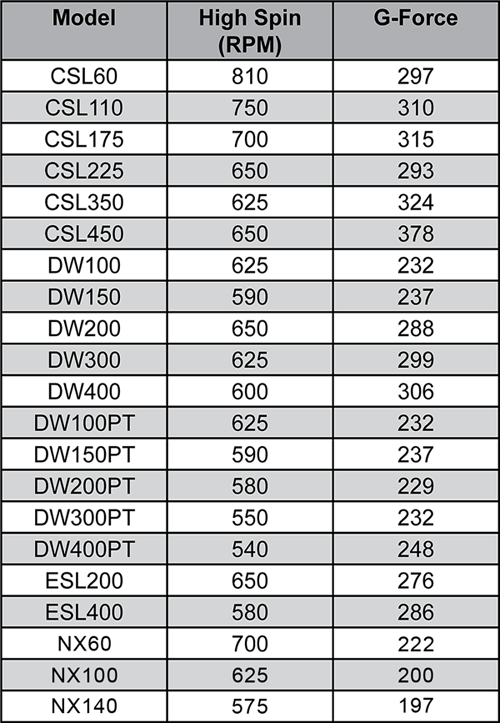Moisture Retention and Extraction
Extraction is the moisture-lowering step used in the laundering process. The process begins with saturation of the textiles. Free water will not accumulate in the washer-extractor cylinder until the textiles have absorbed enough water to become saturated.
For cotton this is approximately 0.3 gallon per pound (2.5 pounds of water per pound of cotton).
For 100% polyester the water retained between the fibers is about 0.1 gallon per pound (0.8 pounds of water per pound of polyester).
Thus, a 350 pound load of cotton will hold about 105 gallons (876 pounds) of water when saturated.
A 350 pound load of 100% polyester will hold approximately 35 gallons (280 pounds).
The amount of water needed for saturation must be added to the amount of free water in the washing cylinders when the water consumption of laundering formulas is calculated. The extract function reduces the water content of textiles to 25% to 70% moisture retention depending on the fabric laundered and equipment used.
Moisture retention describes the ratio of the weight of the retained moisture to the clean dry textile weight. Clean dry weight is most consistently determined in the plant by using the weight after full drying to "full dry state."
- A pound of cotton textile will hold 0.3 gallon of water (2.5 pounds) or 250% of the dry weight
- Extraction reduces retained moisture to 50%, a removal of two pounds of water per pound of fabric
- Since 50/50 polyester cotton retains only 1.7 pounds of water per pound of fabric, only 1.2 pounds would be removed to reach the same 50% moisture retention. However, polyester/cotton textiles come out drier for the same extraction effort.
Extraction is accomplished automatically in the washer-extractor. The pre-programmed PLC shifts the washer into a high-speed rotation following the washing cycle.
Extraction is more cost effective for removing water than dryers, ironers, presses, etc.
Extraction of textiles is enhanced by increased temperature and by the incorporation of fiber lubricants (for example, fabric softeners) in the sour bath of the washing process. In general, the warmer the fabric extracted, the better the moisture removed.
Shown below is a Moisture Retention Chart that demonstrates moisture retention in % when subjected to differing extraction G-Forces. Note that once G-Force exceeds 200G there is a diminishing return on the moisture removed from textiles compared to moisture removal from 50G to 200G.

G-Force is a relative measurement used to compare a washer's extraction capabilities (spin cycle). Comparatively, higher RPM's relate to higher G-Force when the cylinder size is similar. However, larger diameter cylinders can spin slower, yet attain a higher G-Force than smaller diameter cylinders as G-Force is measured at the outermost point of the cylinder.
This is the formula to calculate G-Force: RPM2 x diameter (inches) / 70,500 = G-Force



